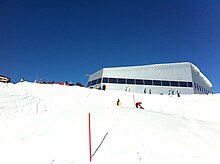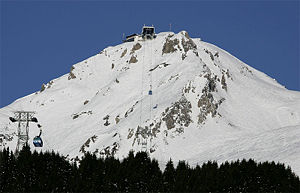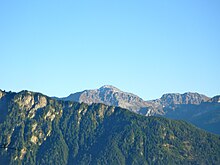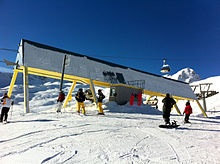Weisshorn (Arosa)
| Weisshorn | ||
|---|---|---|
|
Looking for Weisshorn from the upper lake of |
||
| height | 2653.2 m above sea level M. | |
| location | Canton of Graubünden , Switzerland | |
| Mountains | Plural pen | |
| Dominance | 3.6 km → Tschirpen | |
| Notch height | 286 m ↓ Carmenna | |
| Coordinates | 767 976 / 184478 | |
|
|
||
The Weisshorn in the canton of Graubünden is a mountain in the Swiss Plessur Alps . It is located northwest of the sports and holiday resort Arosa on the border with Tschiertschen-Praden .
Location and description
The Weisshorn is at a height of 2653.2 m above sea level. M. the highest mountain in the mechanically developed Arosa ski area. It is also the highest point in the ridge running northeast from the Hörnlihütte and offers a comprehensive panorama. With ideal visibility, over 660 peaks can be seen from the top, including the Säntis , Piz Buin , Bernina Group , Rheinwaldhorn , Dom , Finsteraarhorn , Jungfrau and Tödi .
The summit section, a rubble dome made of Triassic dolomite , breaks off to the north and west in steep walls. On the Arosa side, it turns into grassy slopes. From the main ridge, ribs radiate out on both sides, which structure the flanks. Neighboring peaks are the Plattenhorn in the southwest and the Brüggerhorn in the northeast. Geologically, the Weisshorn is one of the Arosa Dolomites . Due to its location and the favorable wind conditions, the Weisshorn is a popular starting point for paragliders .
On the southern flank was from 2009 at around 2500 m above sea level. M. temporarily a climbing garden . It consisted of four different sectors ( climbing rocks ) with a total of 16 routes of difficulty levels 4b - 6a. The approach was made by Weisshorngipfel over with cairns marked of trails.
Routes to the summit
Over the north ridge
- Starting point: Tschiertschen ( 1343 m )
- Route: On the Schanfigger Höhenweg towards Ochsenalp. From the corner of Bim Gatter (Pt. 1871) you can reach the west side of the north ridge via the steep lawn of the Ochsenberg, which you can access via Pt. 2493 to the hiking trail above the Sattelhütte
- Difficulty: T5
- Time required: 3 hours
- Special: By far the most demanding ascent
Over the Sattelalp
- Starting point: Innerarosa ( 1857 m )
- Route: On the hiking trail via Sattelalp (2032) and Sattelhütte (2401)
- Difficulty: T2
- Time required: 2 hours
Over the southwest ridge
- Starting point: Carmenna ( 2368 m )
- Route: Easy to the summit over pastures and little rubble
- Difficulty: T2
- Time required: 45 min.
About Maran
- Starting point: Maran ( 1862 m )
- Route: Past Hauptichopf (2158) and Sattelhütte to the summit
- Difficulty: T2
- Time required: 3 hours
Development for sport and leisure
First ski huts
Thanks to its easy accessibility and relative proximity to the village, the Weisshorn quickly developed into the «Arosa Ski Mountain». As early as 1905, a spa guest made the suggestion to build a hut on the summit, but this did not happen for the time being. On the other hand, some members of the Arosa ski club on the Brüggerhorn, on the north-eastern ascent route to the Weisshorn, were able to build the Brüggerhornhütte (Ferdinandshütte) in 1911 , which was replaced in 1930 by the large Weisshornhütte (today: “Sattelhütte”) further up in the saddle at 2401 meters has been. Three years later, the first hut was finally built on the summit, the “Stoffelhütte” built by Hans Höpflinger and demolished in 2007.
Carmennalift (1938–2002) and Carmenna chairlift (since 2000)
In 1938 the AG Autobus- und Skiliftanlagen (today: Arosa Bergbahnen ) opened up the area on the Weisshorn with two first ski lifts . The “Carmenna-Lift” was built on the south-east flank and led from the Innerarosa ice rink to the Untera Tüütschböda area . This T-bar lift overcame a height of 321 meters over a length of 1256 meters. The extension planned in 1944 to the Krähentschuggen , 150 meters below the Weisshorn summit, with an additional "Upper Carmenna Lift" failed due to resistance from the Chur landowners. In 1951 the tug was lengthened by 70 meters to improve the exit. In 1952 the Constam tow hangers were replaced by those from Oehler. In 1968 the lift was comprehensively overhauled by Städeli and from the end of the 1970s hydro towing hangers from Borer and Städeli were used.
In 2000 the facility - like the chairlifts Boordried – Bänkli (built in 1978) and Ried – Krähentschuggen (first detachable quad chairlift in Switzerland, built 1985) - was replaced after 62 years of operation by a detachable quad chairlift from Garaventa (im Popularly known as " Ferrari "), which now leads from the Bergkirchli in Innerarosa to the southwestern Weisshorn shoulder above the bench . An intermediate exit was built at the former terminus of the ski lift. The lowest part of the T-bar lift that was initially preserved was dismantled two years later. In October 2010, the Swiss Cable Car Association (SBS) presented Arosa Bergbahnen AG with the SwissMountain Award , “Special Prize for Design and Architecture”, for the “Carmenna chairlift”. Since the winter of 2011/2012, the entire superstructure of the intermediate exit has been used as a large advertising medium for the Toblerone chocolate product .
Weisshorn lift (1938–1970)
From the Mittlere Hütte on the Tschuggen , the Weisshorn or “Sattel Skilift” led to the northeastern Weisshornsattel. This system - with integrated curves adapted to the terrain - overcame a height difference of 375 meters over a length of 1700 meters. As with the Hörnlilift, guests had to hold onto a safety handle during the journey . The complicated and rather idiosyncratic construction, based on Beda Hefti's patent, already had iron masts in contrast to the other T-bar lifts of the time, which in retrospect is considered to be extremely modern from an architectural point of view (“techno look”). In 1970 the Weisshorn lift was replaced by the Brüggerhorn two-seater chairlift that still exists today .
Weisshornbahn (LAW) (since 1956)
In 1955/56 the Arosa – Weisshorn aerial cableway (LAW / Weisshornbahn), which starts from Arosa train station and runs in two sections via the 2013 m high middle station at Sattelalp to the Weisshorn summit , was built for around 2.8 million Swiss francs . The system built by Von Roll was the largest and fastest (section 2: 10 m / s) cable car in Switzerland. At the same time, the Weisshorngipfel mountain restaurant opened right next to the mountain station. In 1984 the Swiss Post, Telephone and Telegraph Company ( PTT ) set up the directional radiation station on the Weisshorn summit, which is clearly visible from the north and north-west . The LAW was fundamentally modernized in 1992 after 35 years of operation. Since then, the cabins have been able to hold 100 people (1st section) or 125 people (2nd section).
The first section from Arosa to the middle station overcomes a height difference of 261 meters over a distance of 1236 meters, the second section to the summit has a distance of 1963 meters with a height difference of 625 meters.
The valley stations have a special structural feature. Larger gondolas were used during the renovation without changing the structure of the stations. So that the gondolas fit into the stopping position, the middle access walkway was designed to be movable. One side is always in the “closed” state until the gondola in the station has left. Then the middle access walkway is moved to the other side so that the oncoming gondola can enter.
The LAW's safety equipment includes hydraulically driven rescue systems, the double abseiling devices for four people each and the helicopter rescue system with a rescue gondola for six people, plus a rescue lift for 16 people in the second section.
Since summer 2016 - with certain restrictions - mountain bikes have also been transported on the 2nd section .
The Arosa Bear Sanctuary was opened at the middle station in August 2018 .
Summit restaurant (2012)
From 2007, the Arosa Bergbahnen planned to build a modern new mountain restaurant on the summit plateau. The internal Cappa (hat, cap) called project architect Tilla Theus , however, was controversial, particularly in circles of nature and landscape protection. The critics advocated leaving the summit area undeveloped and instead upgrading the existing restaurant on the mountain flank. Due to various objection procedures, the construction work was suspended from July 2007. This was resumed in spring 2011.

The panoramic restaurant with a capacity of 220 people was opened on July 7, 2012. The official inauguration of the CHF 11 million building, which is praised as a new Arosa landmark due to its futuristic architecture, took place on July 14, 2012 with an open day including a jazz dinner subject to reservation . Among the numerous guests were not only general social celebrities, but also politicians such as Councilor Martin Schmid , National Councilor Josias Gasser and Ueli Bleiker, President of the Graubünden at the time . As part of the “Interalpin 2013” cable car trade fair in Innsbruck , the building was awarded the “ISR Architecture Award for mountain restaurants”. The old mountain restaurant has been completely dismantled.
From the opening until autumn 2015, the summit restaurant was run by the former ski racer Jürg Gadient and his wife Sandra. Gadient took care of the small summit pastry shop on the ground floor , which is probably the highest in Europe. There he produced up to 150 cream slices ( mille-feuilles ), several kilograms of pralines and various cakes for sale on the upper floor .
Infrastructure for high altitude training camps
In summer 2012, it was planned to use the former directional beam building , now owned by Swisscom, as accommodation for individual athletes in cooperation with the new summit restaurant. The aim was to develop the summit area into an altitude training camp.
Reservoir "Hintere Hütte"
To ensure that the Arosa ski area is guaranteed to have snow, the Arosa Bergbahnen built a reservoir on the Weisshorn in 2009 for artificial snow-making on the slopes , the Hintere Hütte reservoir .
Major events on the Weisshorn
As early as the 1920s , international, national and regional ski races took place on the Weisshorn - as well as on the Hörnli , Brüggerhorn and Schafrügg - on a regular basis, at the beginning in particular downhill runs with free choice of route. Later on, the well-known "three peaks" or "three piste races" emerged from this. In 1973 the FIS downhill route from the Weisshorn summit to the Bergkirchli was built (length 3350 meters, height difference 750 meters).
As a result, various World and European Cup races for women and men were held on this route, including the World Cup finals in 1978. In the years that followed, the women’s races on the Weisshorn became a fixed point in the World Cup racing calendar: in 1980, 1982 and 1985 there were giant slaloms - or slalom races, downhill runs or Super-Gs also take place from the Weisshorn shoulder. After the races scheduled for December could not take place in 1986 and 1987 due to lack of snow, the organizers decided not to hold further ski world cup races on the Weisshorn.
For some time now, the slopes on the Weisshorn have been used again for FIS races. In addition , snowboard competitions have been taking place at the Carmennahang - in the finish area of the ski races - for several years , such as the 2007 Snowboard World Championship or the 2011 Snowboard FIS World Cup Final . In 2011, the Swiss championships and the 2014 World and European Cup races in ski cross were held on this site . In addition, these pistes also regularly see major popular sports events such as the Rivella Family Contest or the Migros Grand Prix (2014 final).
From the beginning of the eighties until recently there was an international mountain run (later half marathon ) from the Obersee to the Weisshorn summit. The Swiss Irontrail , which was first held in July 2012 , has been running since 2014 from Urdenfürggli - Hörnlihütte via Carmenna - Weisshorn to Arosa and from there via Medergen - Sapün - Strelapass to Davos . The “Arosa Trailrun” has also been crossing the Weisshorn since 2014. As part of the twelfth “Swiss Snow Walk & Run” 2016, the almost 17 km long winter mountain run “Weisshorn Snow Trail” (Obersee – Weisshorn) took place for the first time.
photos
View from Chur to the Weisshorn (1903)
View from Älplihorn , in the back the Ringelspitz
View from the north ( Pagig ) to the Weisshorn
literature
- Tilla Theus and Partner AG, Arosa Bergbahnen AG et al. (Hrsg.): Mountain with cap, the new summit restaurant on the Aroser Weisshorn. ProLitteris 2012.
- Olivier Berger: World architecture excluding the world. In: Terra Grischuna 1/2011, p. 28 ff.
- Manfred Hunziker: Ringelspitz / Arosa / Rätikon , Alpine Tours / Bündner Alps. Verlag des SAC, 2010, ISBN 978-3-85902-313-0 , p. 299.
- The local mountains of the canton of Graubünden. Verlag Rüegger, Chur / Zurich 2003, ISBN 3-7253-0742-3 , p. 20 f.
- SAC Club Guide, Bündner Alpen 1, Tamina and Plessur Mountains. Verlag des SAC, 4th edition 1988, p. 341 f.
- Marcel Just, Christof Kübler, Matthias Noell (eds.) Arosa - Modernism in the mountains. gta Verlag, Zurich 2007, ISBN 978-3-85676-214-8 , p. 52 ff.
- Arosa Bergbahnen AG (Ed.): Bergfahrt - 75 years of mountain railways in Arosa. Weber, Thun-Gwatt 2005, ISBN 3-909532-30-6 , pp. 28 ff., 78 ff.
- http://www.seilbahn-nostalgie.ch/geschichte.html
- Hans Danuser / SC Arosa (ed.): 100 Years of Arosa Ski Club 1903–2003. Self-published by SC Arosa, Arosa 2003, p. 92 ff.
- Hans Danuser: Arosa - as it was then (1979–1995) , vol. 6, self-published by Danuser, Arosa 2002, p. 191 f.
- Hans Danuser: Arosa - as it was then (1947–1961) , vol. 4, self-published by Danuser, Arosa 2000, pp. 77, 146 ff.
- Hans Danuser: Arosa - as it was then (1928-1946) , vol. 3, self-published by Danuser, Arosa 1999, p. 163 f., 224.
- Hans Danuser, Ruedi Homberger: Arosa and the Schanfigg. Self-published by Danuser / Homberger, Arosa 1988, p. 44 ff.
- Swiss Ski School Arosa (Ed.): 50 years of the Swiss Ski School Arosa. Jona 1983, p. 54.
- Luis Trenker , Helmut Dumler: The most beautiful high-altitude trails in the Western Alps. Verlag F. Bruckmann, Munich 1977, p. 140 ff.
- Fritz Maron: From mountain farming village to world health resort Arosa. Verlag F. Schuler, Chur 1934, p. 163 ff.
- Fritz Maron: The History of Arosa Skiing. Verlag Buchdruckerei Arosa, Arosa 1933, pp. 17 ff., 37 ff.
Web links
Individual evidence
- ↑ Photo Carmennalift (around 1940) at www.seilbahn-nostalgie.ch
- ↑ Video clip of the Carmenna ski lift and the Hörnli chairlift (around 1955)
- ↑ Video clip Skilift Carmenna (around 1950)
- ↑ Photo of the Weisshorn lift towing device with safety handle at www.seilbahn-nostalgie.ch
- ^ Photo Weisshornlift (around 1940) at www.seilbahn-nostalgie.ch
- ↑ Video clip Weisshornlift and Sattelhütte (approx. 1940)
- ↑ Video clip Weisshornlift with rarely seen double occupations (approx. 1940)
- ↑ Video clip Weisshornlift with temporary access at the first curve (approx. 1948)
- ↑ Video clip Carmenna and Weisshorn lift with gallery, terminus and saddle hut (around 1955)
- ↑ Weisshorn lift video clip. The manual attachment process is clearly visible (around 1955)
- ^ Photo of the Weisshornbahn (around 1960) at www.seilbahn-nostalgie.ch
- ↑ Video clip with impressions of the LAW (approx. 1960)
- ↑ Video clip with impressions of the LAW and the Weisshorn lift (approx. 1960)
- ↑ Video clip with impressions of the LAW (around 1965)
- ↑ Video clip ride with the LAW 2nd section (around 1988). On the left is the mountain station of the Krähentschuggen chairlift
- ↑ Video clip LAW 2nd section with support at the mountain station (around 1988)
- ↑ Video clip with terrace restaurant and summit impressions (around 1965)
- ↑ Video clip Weisshornbahn 2011
- ↑ Information sheet for the Arosa – Weisshorn cable car, available from the cable car management. Visit to the cable car on September 10, 2014.
- ↑ Aroser Zeitung of June 17, 2016, p. 10.
- ↑ SDA: Arosa: Bear sanctuary opened. In: schweizerbauer.ch. August 4, 2018, accessed November 4, 2018 .
- ↑ Aroser Zeitung of April 28, 2013, p. 9.
- ↑ Neue Zürcher Zeitung of July 4, 2014, p. 56.
- ↑ Video clip downhill race Weisshorngipfel - Kulmwiese (1935)
- ↑ Die Südostschweiz, January 11, 2016, p. 20.



















